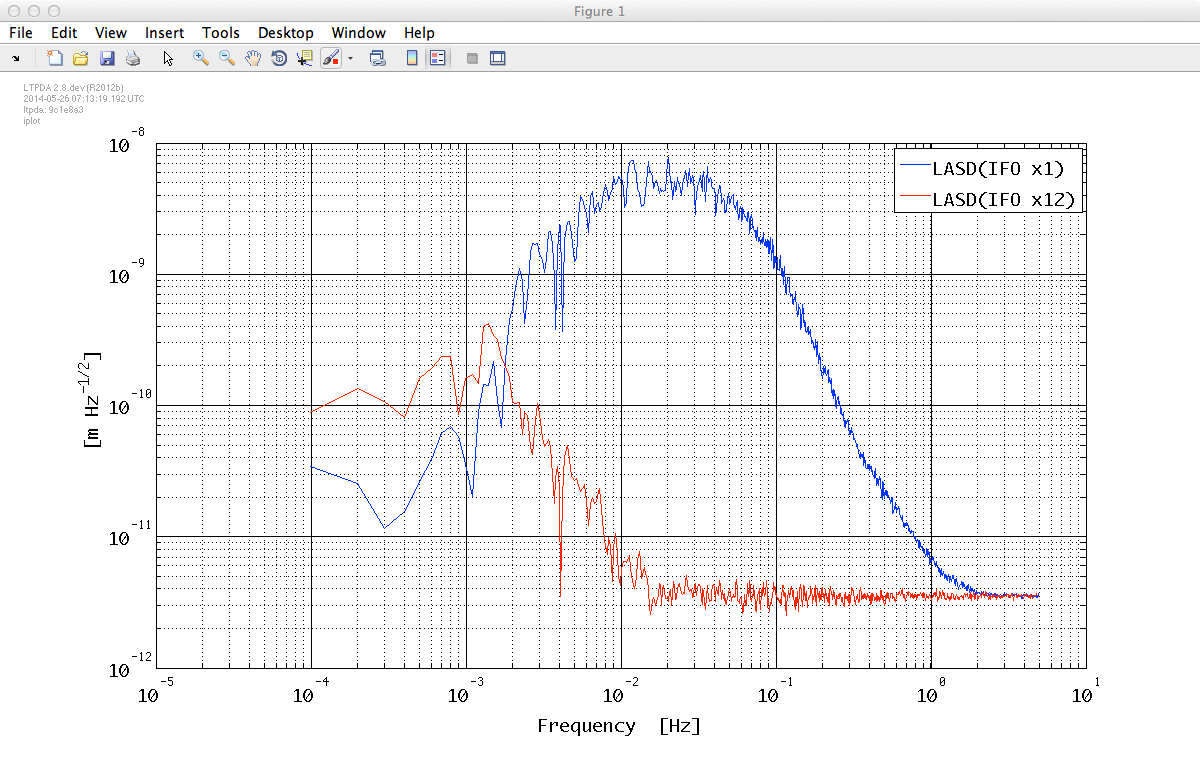

| LTPDA Toolbox™ | contents |   |
The idea of the third exercise is the following:

The step of building aos by loading data from files was touched upon in previous steps and in the user manual. Here we go ahead by calling the ao constructor method, that we want to specify by means of a plist, with parameters:
| Key | Value | Description |
|---|---|---|
|
FILENAME |
'topic3/mockdata_16_48_17_11_2007_1.dat' |
The name of the file to read the data from. |
|
TYPE |
'tsdata' |
Interpret the data in the file as time-series data. |
|
COLUMNS |
[1 2 1 3] |
Load the data x-y pairs from columns 1 (as x) and 2 (as y), in the first ao, and from columns 1 (as x) and 3 (as y), in the second ao. |
|
XUNITS |
's' |
Set the units of the x-data to seconds (s). |
|
YUNITS |
'' |
We leave this empty for now. |
|
COMMENT_CHAR |
'%' |
Indicateds which header lines to skip in the ASCII data file. |
|
FS |
[] |
Indicates to load time series from the first data column. |
|
ROBUST |
'no' |
We don't need robust data reading for these simulated data. |
|
NAME |
{'IFO x1', 'IFO x12'} |
Specify the names of the objects. |
|
DESCRIPTION |
'MDC1 set #1, 17/11/2007' |
Set some text to the 'description' field of the AO. |
x = ao(pl_load);
We can then run all the analyses, and be sure to be applying the same parameters, by passing the vector of aos to the various methods.
We forgot to set the units ... luckily both displacements are expressed in meters, so let's call the method
| ao/setYunits |
| Key | Value | Description |
|---|---|---|
|
YUNITS |
'm' |
The unit object to set as y-units |
Now let's go ahead and use the lpsd method on the ao class. It needs to be specified by setting its parameters. Many of these parameters are the same as we already discussed for ao/psd:
In this case, we will use the following parameters:
| Key | Value | Description |
|---|---|---|
|
WIN |
'BH92' |
Or a different one, if you want. |
|
OLAP |
-1 |
Overlap will be chosen based on the window properties |
|
ORDER |
2 |
Segment-wise detrending up to order 2 |
|
SCALE |
'ASD' |
Evaluate the Amplitude Spectral Density so that [output units] will be [input units] / sqrt(Hz) |
We also need to set other 2 parameters that are typical of this method, discussed in the devoted user manual section.
We will act on the first one, so to decide how many ASD bins to estimate, leaving to the algorithm the choice of their location and the length of the windows on each bin.
| Key | Value | Description |
|---|---|---|
|
JDES |
2000 |
Compromising execution time and resolution |
|
KDES |
10 |
Slightly less than the default value |
|
LMIN |
0 |
The default value |
As we did in previous topics, let's add one ao/iplot step after the call to the ao/lpsd method. We make a little additional exercise: let's specify the color via a plist with parameters:
| Key | Value | Description |
|---|---|---|
|
COLORS |
{[0 0 1],[1 0 0]} |
Setting x1 to blue and x12 to red |
The execution may take some while ... and here are the results:

 |
Example 2: Windowing data | Empirical Transfer Function estimation |  |
©LTP Team